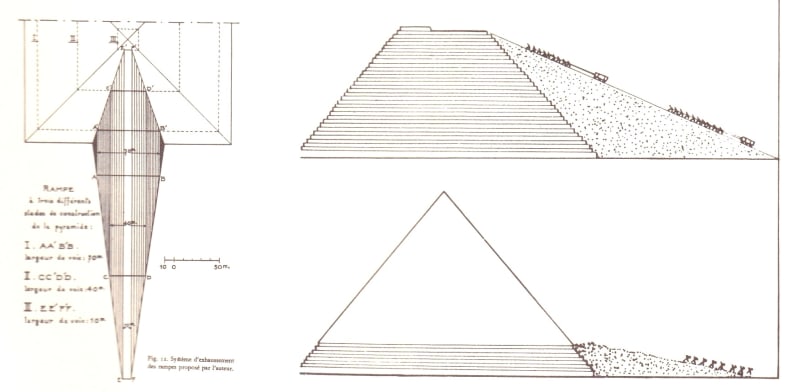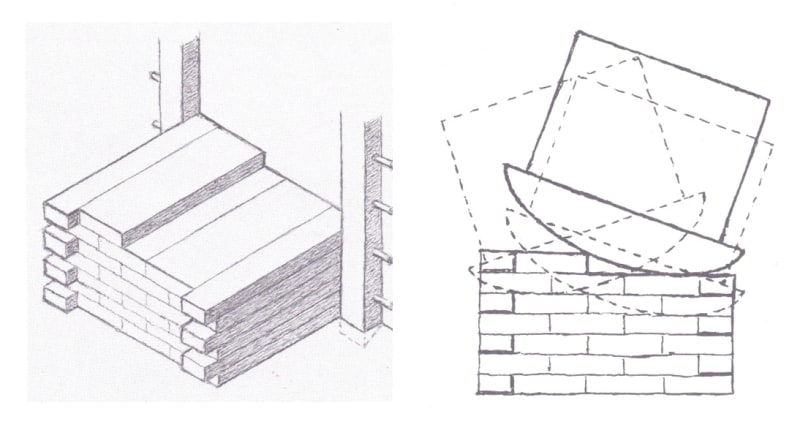Rocking the stones up the pyramids

A collection of architectural curiosities could not be complete without some mention of the Secrets of the Pyramids. This is not the place for the wilder speculations of Pyramidology: that they were temples of initiation into the Egyptian Mysteries, beacons for guiding alien spaceships, accumulators of cosmic energy… There are mysteries enough in the practical question of how these gigantic monuments were constructed.
Many competing theories have been advanced by archaeologists and engineers, about how the hundreds of thousands of stone blocks were raised into position: even today there is no consensus. The Greek historian Herodotus - who visited Egypt, spoke to priests, and obtained detailed measurements - is not all that helpful on the construction process of the Great Pyramid of Giza. He says “the highest parts of it were finished first, and afterwards they proceeded to finish that which came next to them, and lastly they finished the parts of it near the ground and the lowest ranges.”
There *is *agreement about how the blocks for the Giza Pyramid were brought to the site from the rafts on the Nile on which they were transported from the quarries, up a long sloping causeway; indeed, parts of this road have been found. The Egyptians could not have used cranes, since the principle of the pulley was unknown to them; and in any case, where could the cranes have stood?

Several authors including Jean Philippe Lauer have proposed that, as the structure rose, a temporary shallow ramp was built, up which the blocks were slid or moved on rollers, and which was removed again once the pyramid was complete. This might have been a straight ramp leading to one edge, or a spiral ramp wrapped around the four sides of the structure. The difficulty here is that such a ramp would have required prodigious amounts of material itself, and would have needed to be rebuilt and raised, every time a few more courses were added to the pyramid. The removal of the ramp would have been another massive operation.
John Fitchen, in his fascinating book Building Construction Before Mechanization, proposes a method by which blocks of stone could have been raised one level at a time up the stepped slope of the growing pyramid. This involves the use of a rocker device in the form of a wooden cradle with a flat surface on top and curved runners beneath. A block, weighing a few tons, is lifted onto the cradle at ground level using a long counter-weighted balance beam. The cradle is then raised by the following method. Levers are inserted at each end, and two operators rock the cradle back and forth. Other workers insert wooden slabs or shims, alternately at one side and the other. As the piles of shims grow, the cradle and its block are lifted up. The shims are prevented from slipping with zig-zagging ropes, and the rising piles are held between vertical posts. The whole paraphernalia is demountable and can be used again and again.

One such rocking cradle was found at Queen Hatshepsut’s tomb at Deir el-Bahari. Herodotus mentions a type of machine made of ‘short wooden planks’ used in building the pyramids. He says there was one machine on the ground which conveyed a block to the first step, where a second machine lifted it to the second step, and so on. But Herodotus does not describe the ‘machines’ in any more detail.
Fitchen thinks that a team of four men could have raised one block up one level with a rocker in just a few minutes. He draws a comparison with a stunt performed in the old American circus. “A clown sat in a rocking chair, rocking vigorously back and forth while his companions inserted shims back and front. A height of eight or ten feet was achieved in a few moments; then, with no break in the continuity of his rocking, the clown returned to ground level in an equally short time as his companions removed the shims in reverse sequence.”
Fitchen discusses how a block could have been shifted laterally off one rocker onto another, raised up a level, and so on, until reaching its final destination. The mortar used in the pyramids had no adhesive power: it functioned as a lubricant for manoeuvring the blocks into place, and before setting was liquid enough to fill all cavities so that each stone was supported at every point and was not cracked by the huge weight above. Fitchen explains a possible method by which the great capstone might have been positioned at the very summit. Once this was done, the masons would have worked downwards from the top, filling in the steps, removing projections, and creating the final perfectly flat sloping surface. This is presumably what Herodotus is talking about, when he describes the process as moving from top to bottom of the structure. Heaps of fragments from the smoothing work can still be found at the base of the Great Pyramid.
Fitchen’s proposals seem highly plausible. But even he says he cannot be sure, for lack of definite material or documentary evidence, whether a rocker device was indeed the secret.
Peter Tompkins, Secrets of the Great Pyramid, Harper and Row, New York 1971
John Fitchen, Building Construction Before Mechanization, MIT Press, Cambridge Mass 1986